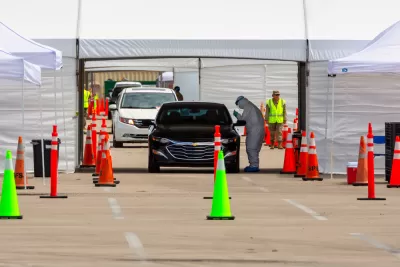A grim warning was issued by the non-profit group that represents America's medical schools and teaching hospitals: if the nation doesn't change its response to the pandemic, "Multiples of hundreds of thousands" of additional deaths may occur.

The 150,000-death milestone was reached on Wednesday, July 29, exactly five months after the first official death was recorded in King County, Washington. Two leading academic organizations have each released plans to "reset" the course the United States is leading in response to the pandemic to reduce future mortality.
“If the nation does not change its course — and soon — deaths in the United States could well be in the multiples of hundreds of thousands," warned David J. Skorton, a cardiologist and president and chief executive of the Association of American Medical Colleges. His organization has published a course correction, which they call a road map, as has the Johns Hopkins Center for Health Security (see header below).
"America needs to change course, and quickly," Skorton wrote in a Washington Post op-ed on July 29. "We should regard our failures as lessons learned — and apply those lessons right away, across the board."
"The Way Forward on COVID-19: A Road Map to Reset the Nation’s Approach to the Pandemic calls on federal and state governments, businesses, academic medicine, and local communities to work together to implement a set of 11 evidence-based, short- and long-term actions to address critical testing and supply issues, mitigate the spread of the virus, and ameliorate the health disparities that have further exacerbated the pandemic for vulnerable populations, among other actions," writes Gabrielle Redford for the Association of American Medical Colleges (AAMC) News.
Based on AAMC experts’ understanding of the pandemic as doctors, scientists, and medical educators, the road map includes such immediate actions as ramping up production of testing reagents and tubes, personal protective equipment, and critical medications; increasing the availability of and turnaround time for testing; and establishing national standards for face coverings, stay-at-home orders, and reopening protocols.
The action that caught my eye was the last one: "4. Establish and enforce national criteria for local stay-at-home orders and reopening protocols." Unlike other groups calling for "start-overs" by states, or better yet, on a national level, AAMC is open to doing it locally.
The nation's first shutdown was done on a regional basis in the Bay Area on March 17. It was successful, leading the way for California and most other states to follow. It was the reopenings, particularly after Memorial Day, where things went dramatically wrong that led to the current resurgence in the South and West that is now spreading north.
However, as Planetizen readers may know, two neighboring, overwhelmingly Latinx counties in South Texas, Hidalgo and Starr, issued stay-at-home orders last week, but due to a gubernatorial executive order, they have no power to enforce them.
Johns Hopkins experts call for "reset"
"The United States needs to restart its response with policy actions at the federal, state and local levels to get control of the pandemic, scholars at the Johns Hopkins University Center for Health Security said in a report," write on July 29, 2020 (source article).
The report [“Resetting Our Response: Changes needed in the U.S. approach to COVID-19”] includes 10 recommendations that include universal mask mandates, federal leadership to improve testing and, in places where rates of transmission are worsening, stay-at-home orders.
For county-specific information on rates of transmission, see Harvard Global Health Institute's COVID Risk Level map (posted here). Orange-colored counties, where case incidence is above 10 but less than 25 per 100,000 people, stay-at-home orders and/or test and trace rigorous programs are advised. Red-colored counties, where case incidence exceeds 25 per 100k, stay-at-home orders are necessary.
"The coronavirus pandemic is the most serious epidemic threat to the United States in a century," concludes the report.
The United States has reached a critical point in the outbreak trajectory, and serious consideration needs to be given to ways in which the response can be improved. The time is now to move forward to reduce transmission and save lives.
How many more lives will be lost?
The point of both reports – which are, in fact, plans for resetting our response to the coronavirus, is to reduce mortality. Barring a dramatic response correction, Michael T. Osterholm of the University of Minnesota has long suggested that as many as 800,000 deaths could occurr, the possible toll resulting from infecting 60 to 70 percent of the population. More recently, he was joined by pandemics preparedness expert, Dr. Irwin Redlener of the Earth Institute at Columbia University.
"If someone had suggested five months ago that we would be seeing more than 3 million cases and 135,000 COVID-19 deaths in the U.S. by mid-July, I wouldn’t have believed it," Redlener wrote on July 17 for the Daily Beast.
But now it’s distinctly possible that, five months from now, half of all Americans could have been infected with SARS-CoV-2, and more than 800,000 Americans may die in this extraordinary outbreak. That is what many of our most prominent public-health experts now expect.
Related in Planetizen:
- Campaign Launched to Halt State Reopenings and Start Over, July 30, 2020
- Do You Know Your COVID-19 Colors? July 29, 2020
FULL STORY: As US passes 150,000 coronavirus deaths, experts at Johns Hopkins call for reset in national response

Study: Maui’s Plan to Convert Vacation Rentals to Long-Term Housing Could Cause Nearly $1 Billion Economic Loss
The plan would reduce visitor accommodation by 25,% resulting in 1,900 jobs lost.

North Texas Transit Leaders Tout Benefits of TOD for Growing Region
At a summit focused on transit-oriented development, policymakers discussed how North Texas’ expanded light rail system can serve as a tool for economic growth.

Why Should We Subsidize Public Transportation?
Many public transit agencies face financial stress due to rising costs, declining fare revenue, and declining subsidies. Transit advocates must provide a strong business case for increasing public transit funding.

How to Make US Trains Faster
Changes to boarding platforms and a switch to electric trains could improve U.S. passenger rail service without the added cost of high-speed rail.

Columbia’s Revitalized ‘Loop’ Is a Hub for Local Entrepreneurs
A focus on small businesses is helping a commercial corridor in Columbia, Missouri thrive.

Invasive Insect Threatens Minnesota’s Ash Forests
The Emerald Ash Borer is a rapidly spreading invasive pest threatening Minnesota’s ash trees, and homeowners are encouraged to plant diverse replacement species, avoid moving ash firewood, and monitor for signs of infestation.
Urban Design for Planners 1: Software Tools
This six-course series explores essential urban design concepts using open source software and equips planners with the tools they need to participate fully in the urban design process.
Planning for Universal Design
Learn the tools for implementing Universal Design in planning regulations.
City of Santa Clarita
Ascent Environmental
Institute for Housing and Urban Development Studies (IHS)
City of Grandview
Harvard GSD Executive Education
Toledo-Lucas County Plan Commissions
Salt Lake City
NYU Wagner Graduate School of Public Service





























